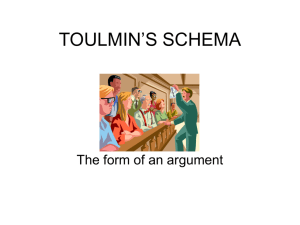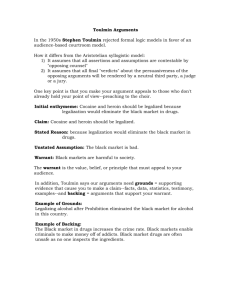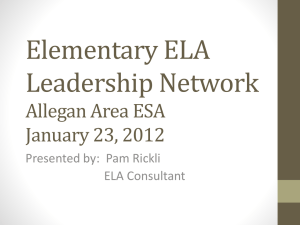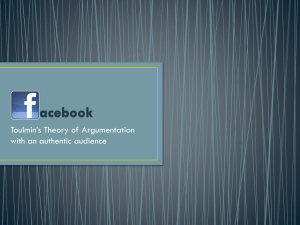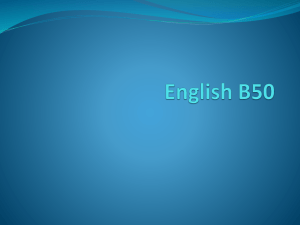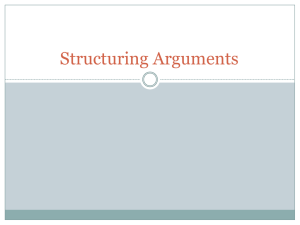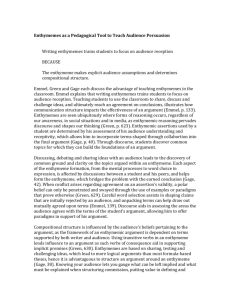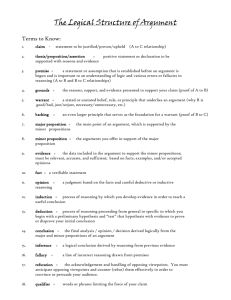The Logical Structure of Arguments
advertisement
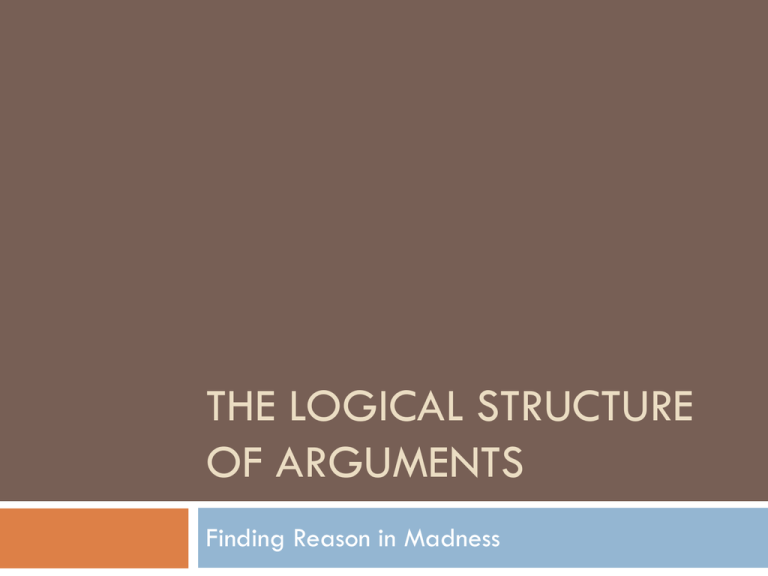
THE LOGICAL STRUCTURE OF ARGUMENTS Finding Reason in Madness Formal Logic vs. Real World Logic Unfortunately, this is not a “logic” class of the philosophical type, where there are certainties. For example, in formal logic, “If all Ps are Qs, and if R is a P, then R is a Q.” That’s pretty defined, and very abstract. Our arguments are…messier. To wit: P=Behaviors constituting sexual harassment Q=Actions that justify dismissal from employment R=Telling off-color jokes. You put it together! Formal Logic vs. Real World Logic This makes a certain logical sense, but not for everyone. We might modify in some ways—telling off-color jokes isn’t ALWAYS sexual harassment. But in certain circumstances… In short, we would need more information than the purely logical argument would provide. We can’t simply say things like ALL Rs are Ps, or that every instance of P results in Q. Hence, consider yourself discouraged from using words like “prove.” We’re not proving anything. At best, we hope to strengthen the resolve of those who agree, or weaken the resolve of those who don’t. The Role of Assumptions Our arguments are not grounded in abstract, catchall statements. Instead, grounded in beliefs, assumptions, or values granted by your audience. As long as assumptions are shared, they can remain unstated. If not shared, well, we have an issue. Revisiting Women in Combat Roles Reason: “Women should be allowed to join combat units because the image of women in combat would help eliminate gender stereotypes.” Seems like a sound, plausible point to argue. But what ASSUMPTION does this argument depend on? What is unstated? Revisiting Women in Combat Roles The assumption at play is one that gender stereotypes are harmful and we would be better off without them. But what if a person believed those roles were biologically based? Divinely intended? Culturally essential? What if a person believes we should fight to maintain them, and not dismiss them? The argument is at risk if the assumption isn’t dealt with. The Enthymeme An enthymeme is an incomplete logical structure, indicating that the argument requires something else to be complete. Comes from the Greek en (in) thumos (mind) The argument is only persuasive if the audience accepts the missing/unstated assumption Enthymeme example Summing Up Claims are supported by reasons. Usually, these reasons can be expressed as because clauses. A because clause attached to a claim is an incomplete logical structure known as an Enthymeme. To complete the structure, underlying assumptions must be clarified. To be effective, this underlying argument should be a belief, value, or principle the audience grants. Thinkin’ About It The Toulmin System Toulmin--a philosopher who dismissed classical logic models in favor of a “courtroom” model based around audience. His model assumes: 1. All assertions and assumptions are contestable by “opposing counsel” 2. All final “verdicts” about the persuasiveness of opposing arguments will be given by a neutral third party (a judge or jury) Toulmin’s Model Forces us to keep the opposition in mind, anticipating their counter arguments and questions. Considering a third party judge or jury reminds us to answer opposing arguments fully, without anger, and to present POSITIVE reasons for supporting our case, and negative reasons for disbelieving the opposing case. Most importantly, keeps us from constructing an argument for people who already agree with you. Warrants WARRANTS are Toulmin’s term for underlying assumptions. Derived from the concept of the “warranty” or “guarantee.” Basically, the warrant is the guarantee of the argument’s soundness. You may already use this term—for example, if you’ve ever said “That’s an unwarranted conclusion.” It indicates that you’ve overstepped your logical situation without cause. There’s nothing to justify that statement or move. Grounds and Backing Alright—so we have a logical structure forming. An Enthymeme (a claim with a because clause) A Warrant (articulating our assumptions) That great! But, we need more. Lots more. These are just statements. The BONES of an argument. According to Toulmin, we need GROUNDS and BACKING in order to “flesh out” our argument for the masses. Grounds Grounds are supporting evidence that cause an audience to accept your reason. Can be facts, data, stats, casual links, testimony, examples, anecdotes. These provide the meat on your bones. IN the courtroom example, it’s “what you have to go on”—the stuff you can point to and present to a jury. Let’s take a look. An Enthymeme with Grounds In many cases, this is all you need for a successful argument. However—what if the audience rejects your assumption? Backing BACKING is the argument that supports the WARRANT. May only require one or two sentences, but could need to be a major component of your argument. A Resistant Audience Often, a resistant audience will offer REBUTTALS— attacks and counterarguments on your assertions. But, these rebuttals are good—they remind us to look at our arguments from the perspective of a skeptic. The best writers will plan for them, anticipate them, and counter them before the arise. The Qualifier Toulmin’s final term—QUALIFIER—serves to limit the force of a claim, indicating a degree of probable truth. Serves to remind us of our inability to “prove” anything. Can be phrases/terms like “very likely,” “probably,” “maybe.” EXAMPLE: “Except in rare cases, women should not be allowed in combat units.” Or, “With full awareness of the potential dangers, I suggest we consider the option of legalizing drugs as a way of ending the ill effects of the black market.” Remember that no argument is 100% persuasive. Using Toulmin’s Schema Working individually or in small groups, imagine that you have to write arguments developing the six enthymemes previously discussed. Use the Toulmin schema to help you determine what you need to consider when developing each enthymeme. We suggest that you try a four-box diagram structure as a way of visualizing the schema. Here’s the Toulmin schema applied to the first enthymeme: We shouldn’t elect Joe as committee chair because he is too bossy.” Power of Audience-Based Reasons Both Aristotle and Toulmin support the need to create “audience-based reasons.” Whenever you consider a piece of persuasive writing, you must couple that with the question “persuasive to whom?” A good reason to you may not be a good reason to others. Thusly, we can have two types of reasons: writerbased and audience-based. The Difference Audience: an environmentalist conference The government should build a dam on the Rapid River because the only alternative power sources are coal-fired or nuclear plants, both of which pose greater risk to the environment than a hydroelectric dam. 2. The government should build a hydroelectric dam on the Rapid River because this area needs cheap power to attract heavy industry. Another Example Gordon, a former contractor, who wishes to be exempted from his University’s algebra requirements. A Problem Gordon’s assertion that Algebra will not be useful in his chosen field flies in the face of his intended audience—a group of professors, most of whom believe and practice “liberal education.” It’s a key belief/value they all share, and walking on it will cause the argument to fail. How could he have been more persuasive? A Better Approach “I should be exempted from the algebra requirement because my experience as a contractor and inventor has already provided me with equivalent mathematical knowledge.” Drops references to algebra’s “uselessness” Honors the faculty’s values and their fear of setting a bad precedent for other students.

